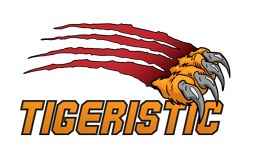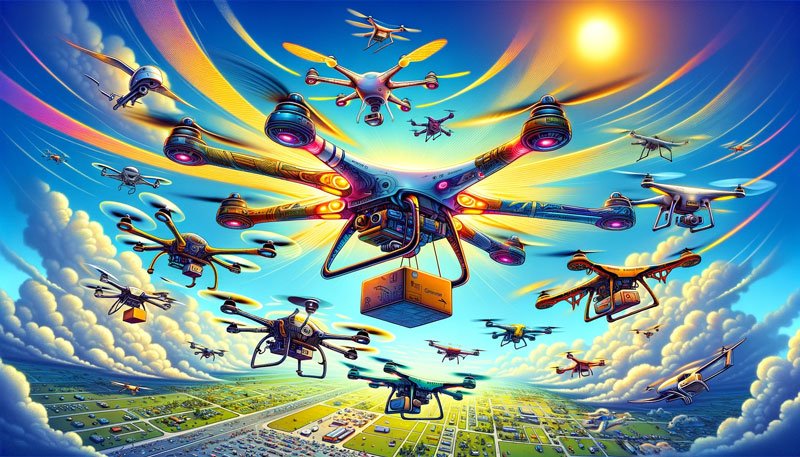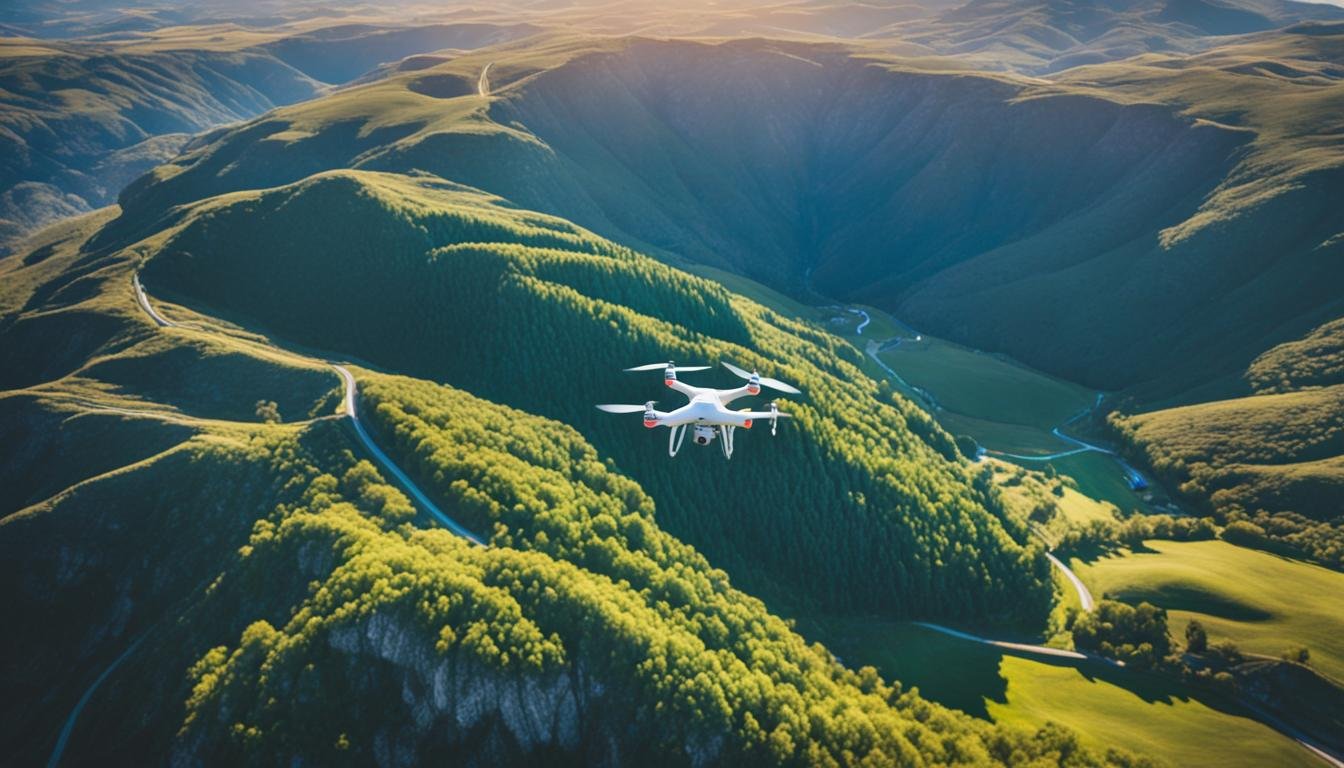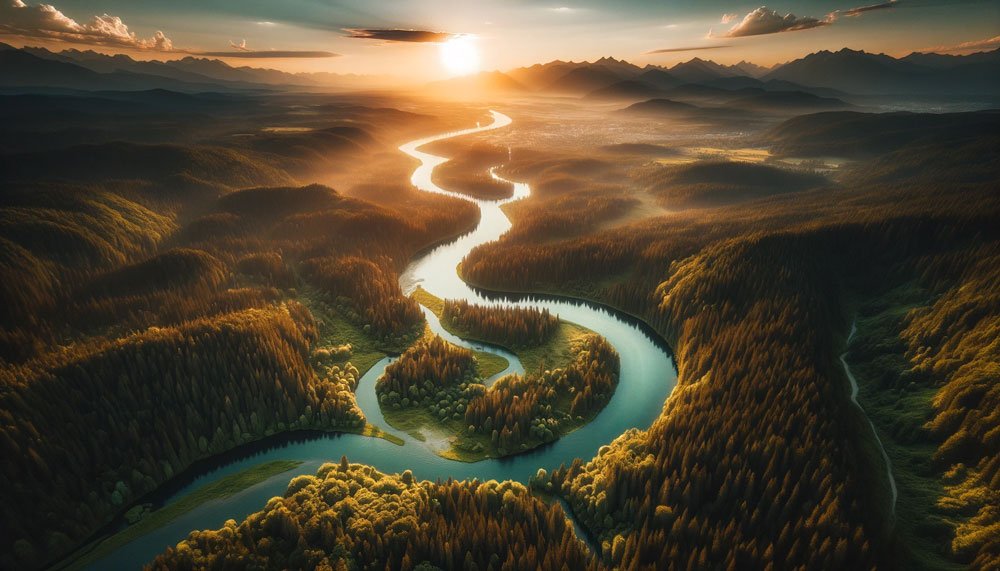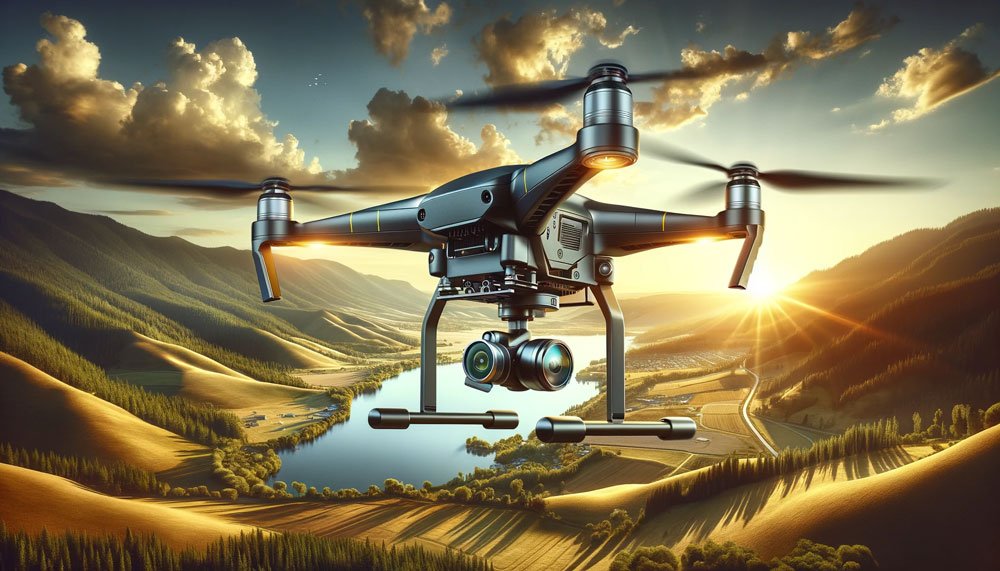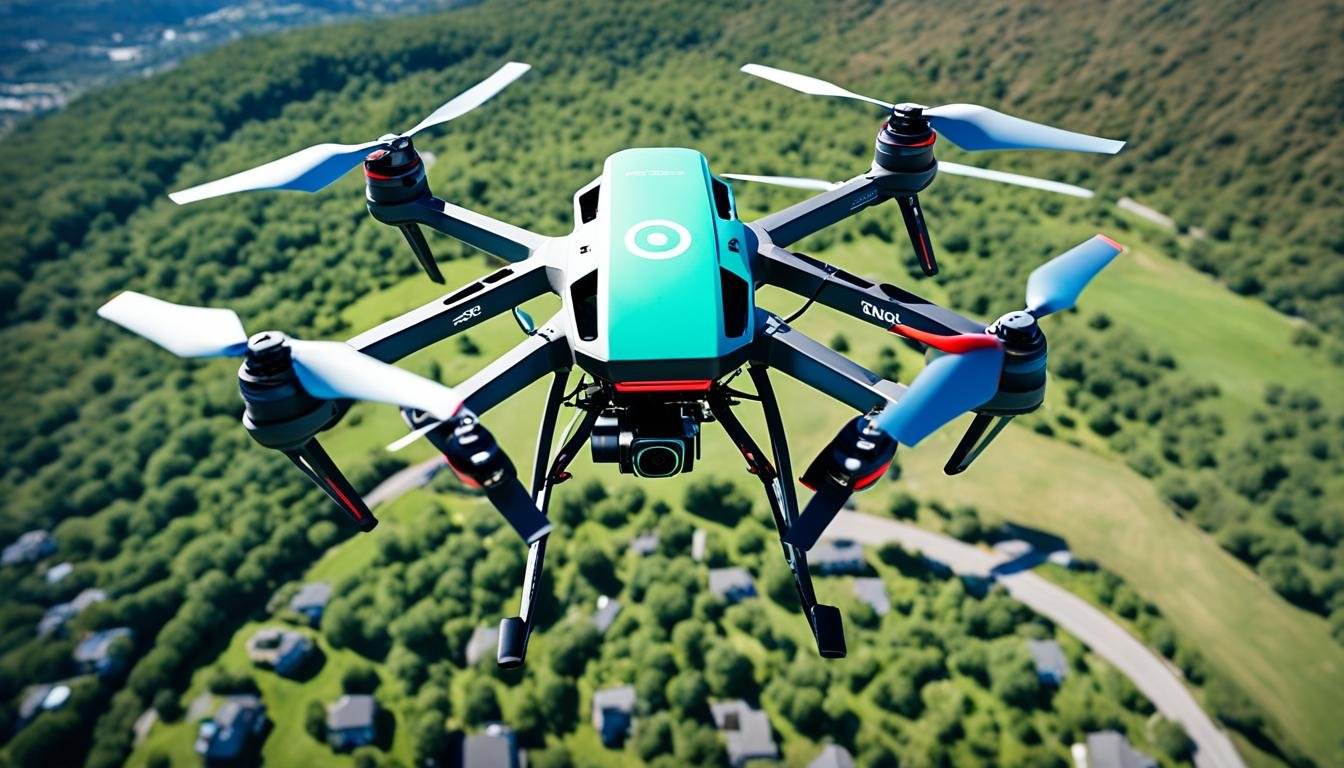As aficionados of aerial videography, we recognize that mastering drone flying techniques is not merely about steering a gadget through the open skies. It’s about choreographing a dance with the wind to capture smooth footage that breathes life into every frame.
Whether we’re sweeping over mountainous terrains or gliding across cityscapes, the pursuit of perfection in drone footage remains constant.
It requires finesse, precision, and a deep understanding of the aerial realm. In this journey to excellence, we shall delve into the fine art of piloting drones, ensuring that our aerial shots are nothing short of extraordinary.
Table of Contents
- The Fundamentals of Drone Flying Techniques
- Pre-Flight Checklist for Optimal Performance
- Advanced Drone Piloting: Elevating Your Skills
- Mastering Drone Navigation Through Obstacles
- Drone Flying Techniques for Capturing Cinematic Shots
- Smooth Operator: Secrets to Silky Smooth Drone Footage
- Aerial Control Tips for Steady and Smooth Videos
- Integrating Smart Drone Maneuvers for Dynamic Footage
- Precision Drone Flying: Techniques for Accurate Positioning
- Conclusion
- FAQ
- What are the most important drone flying techniques for capturing smooth footage?
- How can I build a solid foundation for drone flying?
- What should be included in a drone pre-flight checklist?
- How can I elevate my skills in advanced drone piloting?
- What are the keys to mastering drone navigation through obstacles?
- What techniques are used for capturing cinematic drone shots?
- How can I ensure my drone footage is smooth?
- What are some aerial control tips for creating steady and smooth videos?
- How can smart drone maneuvers enhance my aerial footage?
- How can I improve my positioning for precision drone flying?
The Fundamentals of Drone Flying Techniques
Embarking on the journey to master drone piloting, it’s essential to begin with the core elements that will set the foundation for all future drone maneuvers and aerial control tips.
These fundamentals not only ensure a safer flight experience but also bolster the pilot’s drone flight skills.
We delve into these critical basics, mindful that a solid understanding is the launchpad for sophisticated flights and compelling aerial footage.
Understanding Your Drone’s Basic Controls
Every drone pilot’s quest for mastery begins with the essential step of comprehending the drone’s basic controls. Proficiency in the standard commands – throttle, yaw, pitch, and roll – enables pilots to navigate their drones with confidence and precision.
The throttle adjusts the altitude, yaw controls the rotation, pitch tilts the drone forward or backward, and roll leans the aircraft from side to side. Let us get acquainted with these controls as they are the keystones to our drone flight skills.
Choosing the Right Environment for Practice
Selecting an ideal environment for practicing drone piloting is just as crucial as knowing the controls. We seek spaces that are not only safe but also compliant with local drone regulations to prevent legal issues.
An optimal practice area should have minimal obstructions, be well-lit, and offer enough space for a beginner to maneuver without constraints, thus supporting the development of solid drone maneuvers.
Maintaining Line of Sight While Maneuvering
To maneuver a drone safely and effectively, it’s imperative to maintain an unobstructed visual on the device – a concept known as keeping the ‘line of sight.’ Doing so is not just a best practice; in many places, it’s a legal requirement for drone operation.
It’s a critical aspect of responsible flying that helps prevent collisions and enhances spatial awareness. Our aerial control tips emphasize this point to underscore the importance of both safety and control during flight.
Pre-Flight Checklist for Optimal Performance
Assuring your drone is in top condition before it takes to the skies is essential for optimizing drone performance.
Performing a rigorous pre-flight inspection not only increases the efficiency of drone handling but also significantly enhances the safety and quality of your aerial footage.
Let’s go through the vital steps to ensure your drone is ready for flight.
Inspecting Your Drone Before Takeoff
It’s critical to give your drone a thorough physical check before every flight. This means looking for any signs of wear and tear, ensuring all components are secure, and verifying that propellers are free of damage and properly attached.
Our goal with this step is to prevent in-flight failures that could lead to crashes or subpar footage.
Calibrating Sensors and Checking Battery Levels
Calibration of your drone’s sensors is a step that can’t be missed. Proper calibration ensures your drone flies true and reacts precisely to your controls.
And, of course, starting with a fully charged battery is a must, as well as bringing along spares for longer flights.
This proactive measure supports efficient drone handling and helps avoid unexpected power interruptions.
Assessing Weather Conditions and No-fly Zones
Before your drone leaves the ground, checking the weather forecast is a must for safe flying conditions and optimizing drone performance.
Additionally, be aware of your surroundings and double-check for any no-fly zones that could pose legal complications or safety risks.
| Checklist Item | Description | Importance |
|---|---|---|
| Physical Inspection | Check for damage, and ensure propellers are intact and securely fastened. | Prevents malfunction or accidents. |
| Sensors Calibration | Adjust sensors for accurate performance. | Ensures stability and precise control. |
| Battery Assessment | Verify battery levels are at maximum and spare batteries are available. | Avoids power loss during flight. |
| Weather Check | Ensure favorable weather conditions for the flight. | Prevents weather-induced issues. |
| No-fly Zone Verification | Confirm the area is clear of legal restrictions for drone flying. | Keeps operations legal and safe. |
Integrating these steps into your routine will not only *enhance* the quality of your drone’s in-air performance but also safeguard its longevity.
A meticulous drone pre-flight inspection is a cornerstone of responsible drone ownership and operation.
Advanced Drone Piloting: Elevating Your Skills
As we delve deeper into the realm of advanced drone piloting, it becomes increasingly apparent that mastering drone navigation is not just about handling the equipment—it’s about turning aerial travel into an art form.
Advanced pilots understand that nuanced movements result in footage that transcends the ordinary, crafting scenes that captivate viewers.
Our journey into advanced piloting will demystify methods such as banking turns, where the drone tilts sideways during a turn, enhancing the visual appeal of the footage.
We’ll also cover orbiting maneuvers, a dynamic technique where the drone circles around a focal point, delivering breathtaking panoramic shots. Let’s examine these techniques in detail:
- Banking Turns: Incorporating sharp, yet smooth tilts to create a natural-looking curve that mimics the flight patterns seen in manned aviation.
- Orbiting Objects: Perfecting the balance between maintaining a constant speed and distance from an object to achieve a smooth, circular path around it.
- Altitude Adjustments: Mastering elevation changes to add depth and dimension to your footage, making for a more engaging viewing experience.
| Technique | Description | Tip for Mastery |
|---|---|---|
| Banking Turns | Elegant, curved trajectory | Start with wide arcs, progressively tightening the radius as you grow more comfortable. |
| Orbiting Maneuver | Circular motion around a subject | Use your drone’s intelligent flight modes if available to aid with consistent orbits. |
| Smooth Elevation Transitions | Gradual ascent or descent | Practice throttle control to avoid sudden jerks in altitude. |
Seasoned pilots know that practice makes perfect. Only through consistent practice and a thorough understanding of aerial dynamics can one truly claim to have mastered advanced drone piloting.
Each maneuver we bring into our skill set adds another layer to the captivating visual stories we aspire to tell through our lenses in the sky.
Patience, persistence, and precision are the cornerstones of advanced drone navigation that distinguish the extraordinary from the mundane in aerial photography and videography.
Ultimately, the art of advanced drone piloting hinges on the delicate balance between technical know-how and creative insight.
It’s about pushing the boundaries of what’s possible and consistently exploring new horizons to captivate and amaze with your airborne cinematography.
As drone enthusiasts, we know that precision drone flying is as much about skill as it is about preparation.
Whether the goal is enchanting aerial photography or professional surveying, drones must be navigated with care, especially through landscapes rich with challenges.
Here, we unravel the essentials of drone flight path planning and maneuvering techniques that let us skirt obstacles with the finesse of seasoned pilots.
Planning Your Flight Path
Before propellers even begin to whirl, we map out our flights with meticulous attention. A thoughtful path considers the topography, potential hazards, and specific points of interest.
By leveraging advanced mapping software and our knowledge of the area, we devise a trajectory that not only captures our desired shots but ensures a safe passage for our drone.
Practicing Precision Control
Precision is not a mere buzzword in our vocabulary; it’s a critical factor in the success of drone operations.
Dedication to controlled, delicate movements prevents mishaps and unwanted footage. Such precision in control stems from endless practice sessions, helping hands from trial and error, and the patience to learn from each flight.
Whether in a tight urban landscape or a rugged mountain range, navigating obstacles requires a blend of proactive strategy and reactive agility.
By incorporating exercises designed to simulate various barriers, we ensure our skills are honed to a tee, ready to sidestep an errant branch or a sudden gust of wind.
It’s an ongoing journey of mastering the plays of nature and human influence.
| Aspect of Navigation | Technique/Strategy | Benefit |
|---|---|---|
| Environmental Assessment | Use of real-time weather updates and topographic data | Prevents flying into adverse conditions; aware of land features |
| Software Assistance | Engagement of flight simulation software for practice | Improves pilot reflexes and familiarizes with potential scenarios |
| Control Proficiency | Regular drills on fine-tuning inputs | Develops muscle memory for delicate maneuvers |
| Obstacle Awareness | Practice flights in diverse environments | Trains pilot in recognizing and reacting to unexpected barriers |
By embracing the intricacies of drone flight path planning and mastering the art of navigating obstacles, we set ourselves apart from casual flyers.
Our perseverance in fine-tuning these tactics supports our quest to achieve breathtaking, unblemished drone footage, assuring us a place among the ranks of precision drone flying connoisseurs.
Drone Flying Techniques for Capturing Cinematic Shots
When we set out to create cinematic drone shots, we must approach our aerial cinematography with both creativity and technical skill. Mastering drone navigation allows us to move beyond standard aerial shots and into the realm of storytelling from the sky.
The techniques we employ can transform a simple drone clip into a powerful piece of cinematic artistry.
Let’s delve into the flight patterns, camera angles, and speeds that contribute to impactful aerial storytelling.
Flight Patterns: The paths our drones carve through the air can evoke different emotions and narratives. A slow ascent, for example, might reveal the grandiosity of a landscape, while a rapid descent can introduce a sense of urgency. We must think like directors, using movement to guide the audience through our visual tale.
- Ascending and descending shots
- Orbiting around subjects of interest
- Following a path that reveals a story
- Panning across scenes to show scale and scope
Camera Angles: Whether we perch our lens high above the action for an omniscient viewpoint, or hover just feet off the ground for an intimate close-up, camera angles are pivotal in setting the scene. Our drones become the eyes of the audience, and through mastery of camera control, we shape their perspective and emotional engagement.
- High-angle shots for a commanding view
- Low-angle shots to dramatize subjects
- Side-angle shots for depth and dimension
- Direct overhead shots for a unique contextualization
Speed and Tempo: The pace at which our drone moves plays a significant role in the storytelling. A swift flight can inject adrenaline, while a languid glide offers a moment of reflection. Skills in throttle control and maneuvering are essential for executing these paces with precision.
We craft scenes in the sky—each movement, each frame, a brushstroke in our aerial canvas.
In conclusion, the fusion of these elements—flight patterns, camera angles, and speed—enables us to produce cinematic drone shots that captivate and resonate.
As we continue to explore the skies, let our creativity and technical prowess in drone navigation work in concert to produce truly magnificent aerial shots that tell our stories from above.
Smooth Operator: Secrets to Silky Smooth Drone Footage
To capture the kind of drone footage that truly astounds, it requires a seamless blend of technique and technology.
Part of our secret lies in how we handle the gimbal movements to produce stable and fluid shots, whether we’re soaring high above or gliding gently along a scenic landscape.
Integrating slow and controlled motion in our flights and finessing reveal shots enables us to create videos that are a visual treat.
Utilizing Gimbal Movements to Your Advantage
When we talk about the gimbal, we’re referring to the motorized axis that stabilizes the camera for that coveted smooth footage, even when the drone tilts or jostles in the wind.
By mastering gimbal maneuvers, such as tilt, pan, and lock, we ensure our footage remains level and fluid, no matter how dynamic the drone’s movements may be.
Mastering the Art of Slow and Controlled Motion
There’s an undeniable art to executing slow and controlled drone motion. It’s not about rushing from point A to point B, but rather gently cruising through the air and granting viewers the time to absorb every detail of the scene.
This disciplined approach guarantees that transitions between shots are virtually imperceptible, leaving audiences enraptured rather than distracted.
Perfecting Reveal Shots and Fly-throughs
Reveal shots have the power to captivate an audience, peeling back layers of the landscape to disclose hidden gems.
Fly-throughs, on the other hand, provide a bird’s-eye view that transports viewers through a dynamic space, threading the needle through intricate environments.
These maneuvers require a harmonious blend of pilot skill and drone capability for seamless execution.
| Technique | Use Case | Benefits |
|---|---|---|
| Gimbal Tilt | Vertical reveals | Create anticipation and reveal the height |
| Gimbal Pan | Horizontal movement | Showcase landscapes smoothly |
| Controlled Motion | Steady flyovers | Avoid motion blur; enhance focus |
| Reveal Shot | Introducing a scene | Engage viewers with a surprise element |
| Fly-through | Passing through tight spaces | Immersive perspective; dynamic storytelling |
Aerial Control Tips for Steady and Smooth Videos
Ensuring that your drone captures steady and smooth videos is essential to high-quality aerial cinematography. Implementing effective aerial control tips can dramatically improve the stability of your footage.
Let’s delve into the nuances of optimizing your drone’s speed settings, understanding common control mistakes, and mastering the use of GPS mode for heightened precision.
Adjusting Your Drone’s Speed Settings for Better Stability
One key factor in achieving steadiness in the skies is the ability to adeptly adjust your drone’s speed settings. A slower speed can enhance stability as it allows for finer control during flight, which is ideal for capturing those tranquil, floating shots that mesmerize viewers.
Learning from Common Mistakes in Pitch and Yaw Controls
Getting to grips with pitch and yaw controls is crucial for fluid movement. Be aware of the common errors, such as over-rotations or abrupt changes, which can lead to shaky footage and sudden, unwanted shifts in perspective.
Expert Usage of GPS Mode for Precision Flight
Utilizing your drone’s GPS mode is instrumental for precision flight, especially when filming in challenging conditions or capturing complex maneuvers. The integration of GPS vastly improves positional accuracy, making it a valuable tool for professional-grade video production.
| Tips for Drone Speed Settings | Common Pitch and Yaw Mistakes | Advantages of GPS Mode |
|---|---|---|
| Begin with a slow speed for greater control | Avoid rapid directional changes | Enhances positional stability |
| Gradually increase to find a balance | Maintain smooth and consistent rotations | Allows for precise location tracking |
| Use environment-aware settings adjustments | Lean on automation features with caution | Ensures more accurate return-to-home functionality |
Integrating Smart Drone Maneuvers for Dynamic Footage
To transform ordinary aerial shots into dynamic aerial footage, it’s essential to integrate smart drone maneuvers that not only captivate viewers but also highlight the capabilities of the drone and the pilot.
Complex maneuvers add layers of depth and excitement, showcasing advanced drone flying techniques and capturing the essence of modern aerial videography.
Let’s break down several drone maneuvers that are guaranteed to elevate your footage from basic to breathtaking. We’ll dive into the mechanics of each maneuver and how they contribute to a more vibrant and engaging video composition.
- The Dronie: Cutting through the sky while focusing on a subject, the drone smoothly retreats and ascends, creating an epic reveal of the surrounding landscape.
- The Orbit: Circling a point of interest flawlessly combines smooth turns with continuous focus, resulting in footage that offers a unique 360-degree perspective.
- Tracking Shots: Following a moving subject with precision demands a steady hand and eye for motion, capturing footage brimming with kinetic energy.
Incorporating these maneuvers into your projects demands practice and an in-depth understanding of both your drone’s technical capabilities and the environmental factors at play. Below is a guide to harnessing these maneuvers effectively:
| Maneuver | Technique | Use-case |
|---|---|---|
| Dronie | Start close to the subject, then fly backward and upward in a single smooth motion. | Revealing landscapes; highlighting scale in comparison to the subject. |
| Orbit | Maintain a constant speed and altitude while circling the subject using yaw and roll controls. | Offering a panoramic view; creating interest in stationary subjects. |
| Tracking | Keep the subject in the frame while adjusting the drone’s position to mirror the subject’s movement. | Dynamic action sequences; following vehicles or wildlife. |
Mastering these smart drone maneuvers will not only add a wow factor to your dynamic aerial footage but also affirm your expertise in cutting-edge drone flying techniques. Pushing the boundaries of what’s possible with drone cinematography starts with embracing innovation and continuous practice.
Precision Drone Flying: Techniques for Accurate Positioning
As drone enthusiasts keen on capturing the essence of the world from above, we understand the necessity of precision drone flying and accurate drone positioning.
It’s these skills that allow for the creation of stable drone shots, turning good footage into great. Now, let’s break down these techniques into practical steps.
Mastering the Hover for Stable Shots
To achieve the coveted stability in your shots, a masterful hover is essential. It is the backbone of precision drone flying, which requires both patience and practice.
By maintaining a steady hover, you can ensure that each frame is clear and stable, allowing for high-quality visuals and a professional feel in the final product. Here’s our technique:
- Initiate a low-altitude hover and gradually increase elevation.
- Constantly adjust throttle and directional controls to counteract drift.
- Practice in various weather conditions to enhance skill and adaptability.
Executing Sharp Turns and Curves with Finesse
Next, let’s focus on maneuvering with finesse. Sharp turns and sleek curves are critical when navigating through tight spaces or capturing compelling footage.
To ensure accurate drone positioning, gradual control inputs and anticipation of the drone’s momentum are vital. Follow these pointers:
- Begin with wide arcs and progressively tighten your flight path.
- Maintain a steady altitude to avoid elevation loss during turns.
- Utilize your drone’s yaw control sparingly for smoother motion.
Practicing Deceleration for Smooth Endings to Shots
Finally, a smooth deceleration is the hallmark of a skilled drone pilot. It allows a shot to naturally and gracefully come to an end, rather than an abrupt halt that can disrupt the viewer’s experience. To master this:
- Gradually reduce the throttle ahead of your intended stopping point.
- Anticipate inertia and use gentle reverse inputs to steady the drone.
- Rehearse the transition from motion to hover until seamless.
Remember, these techniques go beyond mere maneuvers. They’re an art form that when perfected, significantly raises the caliber of your stable drone shots.
It’s about painting the skies with precision and bringing a cinematic quality to every angle. With these steps as your guide, the skies will not just be your canvas, but the beginning of a storytelling journey that soars.
Conclusion
Throughout our comprehensive guide, we’ve established a solid framework for mastering drone flying, underpinning the importance of precise control, advanced maneuvers, and creative vision in capturing breathtaking aerial footage.
With the drone industry rapidly evolving, embodying the essence of continuous learning is vital for both novices and seasoned pilots to refine their aeronautical repertoire and remain influential in the aerial cinematography arena.
Summarizing Key Takeaways for Mastering Drone Flying
We’ve traversed from the ground up, laying out fundamental flight skills, advancing through complex navigation, and culminating in cinematic artistry.
These pillars not only enhance drone flight skills development but ensure that each shot you take translates into a stunning visual narrative.
Recognizing these elements as a journey rather than a destination cements the concept that mastering drone flying is an ever-evolving skill set, demanding persistence and adaptation.
Encouraging Continuous Practice and Learning
In pursuit of excellence, we emphasize the significance of ongoing practice and learning. The path to proficiency is paved with the trials of trial and error, each flight a lesson, each error an opportunity to grow.
As we wield our controllers, it’s our dedication to the craft that elevates us from enthusiasts to auteurs of the skies—our shared ambition, the catalyst for breakthroughs in aerial innovation.
Sharing Resources for Further Drone Flight Skills Development
As part of our commitment to your growth, we urge you to seek out communities, forums, and workshops that can provide guidance and camaraderie.
The wealth of knowledge within the drone community is vast, and tapping into it is key for drone flight skills development.
Keep the propellers of curiosity whirring, and you’ll find that with each flight, your competence and confidence will soar to new heights.
Let’s keep our eyes on the horizon and our drones in the skies as we push the boundaries of what’s possible in aerial photography and videography.
FAQ
What are the most important drone flying techniques for capturing smooth footage?
Smooth footage is achieved through steady drone operation, mastering controls such as the gimbal, utilizing slow and controlled movements, and practicing advanced maneuvers like banking turns and orbits.
How can I build a solid foundation for drone flying?
Understand your drone’s basic controls, choose the right environment for practice, and always maintain the line of sight. Being familiar with your drone and responding to its behavior is essential.
What should be included in a drone pre-flight checklist?
Inspect your drone’s condition, calibrate its sensors, check battery levels, and assess the weather conditions and potential no-fly zones to ensure optimal performance and safety.
How can I elevate my skills in advanced drone piloting?
To elevate your piloting skills, practice complex maneuvers like orbiting objects, making banking turns, and changing elevations smoothly for more dynamic aerial shots.
Precise flight path planning, honing control for exact movements, and understanding how to navigate around both natural and man-made obstacles are essential for mastering drone navigation.
What techniques are used for capturing cinematic drone shots?
Utilize a variety of flight patterns, camera angles, and speeds to enhance the storytelling aspect of your drone footage. Understanding the way your drone moves can greatly contribute to the cinematic quality of your shots.
How can I ensure my drone footage is smooth?
Achieve smooth footage by mastering gimbal movements, practicing slow and controlled flight, and perfecting specialized techniques like reveal shots and fly-throughs.
What are some aerial control tips for creating steady and smooth videos?
Adjust your drone’s speed settings for better stability, learn from common mistakes in pitch and yaw controls, and expertly use GPS mode to maintain precision in your flights.
How can smart drone maneuvers enhance my aerial footage?
Integrating maneuvers such as “drones,” orbits, and tracking shots can add dynamic elements to your footage, making it more exciting and professional.
How can I improve my positioning for precision drone flying?
Focus on mastering the hover for stability, executing sharp turns and curves with finesse, and practicing smooth deceleration for clean endings to your shots.
